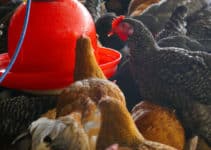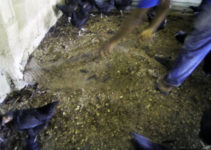How to Treat Louse and Mites in Your Poultry and Farm Animals
Louse and mites are capable of causing a lot of economic loss to the farmer if not properly check and prompt action taken to prevent further damage.
Physical Structure and Characteristics of Lice and Mites
- The life cycle from eggs to adults lasts for about three to four weeks.
- It is wingless with a flat body
- It belongs to the Arthropoda and the class insect
- Its body is divided into head, thorax, and abdomen.
- It has three pairs of jointed walking legs.
- The mouth part is for biting and sucking
- It legs eggs called nits
- The eggs hatch into nymphs and nymphs develop into adults
- Adults are transmitted from host to host by body contact Hosts include wild birds and rodents as well as poultry.
- Infestations of louse and mites can occur at any time of the year.
- Mites generally spend their entire life on or near the host.
- The life cycle can be complete in as little as 5 days.
- Hide off hosts during the day in nest boxes, cracks, and crevices. Feed on hosts at night.
- Workers may experience bites, itching, or rashes.

Recommended for you:
The Health Impacts of Ticks on Livestock Production, It’s Control and Characteristics.
Dangers of Rats, How to Eliminate Them from Your Farm, Home, and Property
25 Tips on the Prevention, Care, and Management of Snakebite
Economics Importance
- It sucks a large volume of blood thereby leading to anemia or excessive loss of blood.
- Its bites can cause severe irritation
- Heavy lice infestation can lead to restlessness
- drop in egg production
- The productivity of the animal will automatically reduce
- Scratching for the bites results in sores
- Low hatchability
- Increased feed intake and increased mortality.
- The sores may create room for pathogens to attach to the animal
- Louse and mites infestation may result in emaciation or loss of weight
- Heavy lice and mites infestation can cause death in poultry
READ ALSO:
Drop-In Egg Production: 10 Ways to Make a Significant Improvement
How to Ensure Good Hygiene and Bio-Security in Your Poultry Farm
Chickens: 9 Reasons Why Your Family Needs This Amazing Bird
Treatment and Control of Louse and Mites
- Maintain good sanitation
- Before introducing new birds and farm animals into your flock ensure that they are free from lice and mites quarantine them for some days to ascertain that they are free from such insects
- If you notice that you have a louse and mites infestation take everything out of the coop and clean it. Bedding, roosts, feed, nest boxes and bedding, feed bins, any containers to have a thorough cleaning.
- Remove your chickens from the coop. don’t try to treat it when they’re around, if you are using chemicals it may affect them.
- Mites are found of finding places to hide, and everything must be meticulously cleaned if you’re going to get rid of them.
- After washing your poultry equipment, expose and spread them in the sun.
- The beddings such as sawdust, sand, rice husk, etc. should be properly and completely burned and replaced with entirely new ones. This is to avoid eggs and larvae as well as the mites themselves harboring in some corners of such equipment. when burning all equipment’s ensure that you are visibly present throughout the period ensuring that the fire is completely quenched to avoid fire outbreak and disaster.
- In treating louse and mites ensure good litter management by forming good compost will help form good healthy bacteria.

Chickens preening, scratching, sunbathing and dust bathing is a natural way of controlling louse and mites.
Further Measures
- If you want to treat louse and mites naturally provide a conducive environment for your chickens to be able to dust bath and sunbath this will provide a natural way for your chickens to shed parasites like mites and lice. This is natural ways your birds can take care of both lice and mites.
- You can help your chickens to fight lice and mites by providing dry materials such as sand, wood ash, Diatomaceous Earth in the chicken coop this will help them greatly to fight insects.
- Other control measures include regular dipping of animals in a solution containing acaricides
- You can also spray the animal host with insecticides and solutions. These solutions can easily be found in veterinary hospitals, or where poultry drugs and feed are sold. Endeavor to read properly the manufacturer’s instructional manual.
- One of the best ways to prevent louse and mites is to avoid overcrowding of animals
- Regular brushing of the body of animals will help in control louse and mites
- Isolate infected animals.








Thank you very much for this write up. Though I have never experienced lice/mice on my poultry. It is in my sheep that i encounter them especially during the rainy season. I use insecticide to treat them. But now I will try using the ash.
its ok, striving to provide a more natural environment for your birds to sunbirth, dustbirth and scratch their body will greatly help to.
I don’t think the title of your article matches the content lol. Just kidding, mainly because I had some doubts after reading the article.
Can you be more specific about the content of your article? After reading it, I still have some doubts. Hope you can help me.